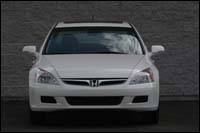More than just batteries
The hybrid debate continues. Are they worth it? Do you in fact save money? What are they like to drive? Do they represent a viable option for those, like you and I, who want to reduce their gas bill and help out the environment? If we read the newspapers and the web, we get very different messages. One of the most recent items of news that I have read had to do with fuel cell technology trumping hybrids. What is one to do? Anyhow, let us get back to the matter at hand.
The present day Accord was launched in 2003 and received, for the 2006 model year, a rear-end revision and a few other aesthetic changes. In 2005, Honda introduced the first ever Accord Hybrid. They presented the car to the media and the public as a faster and greener version of the Accord sedan. Even today, the first word you will find in the hybrid's overview is powerful. Is this the way to promote a "green car"? Is there no better way?
There are 2 trims for the Hybrid. The base version retails f or $37,990. The other trim level includes navigation and a sunroof and has an asking price of $40,590. This is the one I have tested.
or $37,990. The other trim level includes navigation and a sunroof and has an asking price of $40,590. This is the one I have tested.
Styling
In 2003, Honda left the rounded out corners and smooth flowing body lines behind. They instead chose to sharpen angles to make the new substantial car look more extensive. I, for one, always thought that the Accord was pleasant to gaze at, however others expressed their preference for the previous car's more subdues allure was more elegant. I must admit that the redesigned for 2006 taillights, bumper and trunk-lid, have a far better, more finished appearance over 2005.
The cabin of the Hybrid is as appealing as ever. It is characterized by
spot-on ergonomics, impressively supportive and comfortable seats and above average fit and finish. The Acura influence is obvious; the materials are top-notch and the dashboard's design is unique. The gauges of the Hybrid offer a glimpse of what is going on when we drive the car. We find the habitual charge (through regenerative braking) and assist bars that move back and forth and perhaps the most significant part of Honda's IMA (Integrated Motor Assist) system, the ECO mode indicators. When the little green light is on, the driver is made aware that the Variable Cylinder Management mechanism is working.
My tester featured Honda's excellent touch-screen navigation system. A more user-friendly system, I do not know of. The menus and options are simple to select and the GPS positioning is very precise.
On the road
This is the beauty about the Hybrid, it requires no adaptation period. You start the car and drive off. There are many things going on at the same
time though. Under normal driving conditions, the V6 does the work. If you find yourself in a little bit of a rush and accelerate hard, the hybrid system will assist the gas engine for more accelerating or passing power. When coasting or braking, the regenerative braking system recharges the batteries. And, in most cases, when you come to a full stop, the engine will shut itself off automatically. What is most important, I find, is that when cruising at a steady rate, the Variable cylinder management system shuts off 3 of the 6 cylinders for better fuel efficiency. All of this occurs without driver input. Problem is that my returned average fuel consumption over 1 000 km in a week was of 8.75L / 100 km. This is only about 10% better than the last Accord V6 I drove.
 |
The present day Accord was launched in 2003 and received, for the 2006 model year, a rear-end revision and a few other aesthetic changes. In 2005, Honda introduced the first ever Accord Hybrid. They presented the car to the media and the public as a faster and greener version of the Accord sedan. Even today, the first word you will find in the hybrid's overview is powerful. Is this the way to promote a "green car"? Is there no better way?
There are 2 trims for the Hybrid. The base version retails f
 or $37,990. The other trim level includes navigation and a sunroof and has an asking price of $40,590. This is the one I have tested.
or $37,990. The other trim level includes navigation and a sunroof and has an asking price of $40,590. This is the one I have tested.Styling
In 2003, Honda left the rounded out corners and smooth flowing body lines behind. They instead chose to sharpen angles to make the new substantial car look more extensive. I, for one, always thought that the Accord was pleasant to gaze at, however others expressed their preference for the previous car's more subdues allure was more elegant. I must admit that the redesigned for 2006 taillights, bumper and trunk-lid, have a far better, more finished appearance over 2005.
The cabin of the Hybrid is as appealing as ever. It is characterized by
 |
My tester featured Honda's excellent touch-screen navigation system. A more user-friendly system, I do not know of. The menus and options are simple to select and the GPS positioning is very precise.
On the road
This is the beauty about the Hybrid, it requires no adaptation period. You start the car and drive off. There are many things going on at the same
 |


